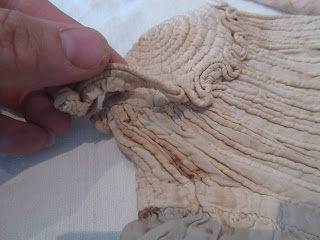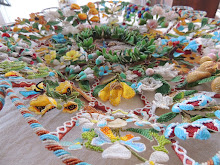First Quarter 19th c Child's Gown & Cap
I often get questions on how to wash items, and what I use to wash them with. I cant offer a blanket statement that I use product X to wash with because honestly, every article of early clothing is its own unique situation. Every stain is unique...is it organic? Is it grass? Is it clay? Is it blood? Then one must take into consideration the fibers of the material~ are they natural or synthetic? Cotton? Linen? Silk? You get the idea. But I can offer my recommendation on how to remove overall dinginess from cotton or linen.
First I must determine if the textile is strong enough to withstand a wet wash. Textile fibers are very fragile when wet. Just the weight of the water in the fiber can be enough to tear sheer textiles like cotton mull. Does the garment or textile have any metal bits like fasteners or buttons? I never wet wash any item with metal parts. Another thing to consider is trims...for example, early sequins around the turn of the 20th century were made from celluloid and literally dissolve in water. Does the textile have any colour to it? Be it printed or woven, not all colours are colour fast, so one must check in an inconspicuous place to see if the colours bleed. If I am preparing for a spot check, then I first ask myself what is the purpose of the washing? I usually choose not to wash 95% of the time. Stains are part of the history of a piece. They help to tell the story of how a piece of clothing was worn. Stains can talk! Occasionally I have a piece that could benefit greatly from a freshening up, such as this set here of early Empire period gown and corded cap. The above picture is before washing. The gown is overall just quite dingy, with a real yellow~brown cast. Only on close inspection could one realize it was made of a woven pink and brown stripe cotton.
Because fibers are so fragile when wet, I check for any rips or tears in the piece. If they are able to be stabilized before washing, I will do so. The rouleaux trim at the base of the crown on the cap was partially detached, as shown above.
The trim was carefully stitched back in place through the original stitch holes before being washed.
It is only then that the textiles are carefully placed FLAT into the bath. I gently press down with a flat hand to coax out any air bubbles. There is NO AGGITATION. I put the lid on and let this set for at least 24 hours.
 But to not be so garrish that they attract attention over the construction of the piece, or the fabric, or the overall design. Most of these stains were probably from storage, being laid directly on wood or acidic paper linings in a chest or trunk.
But to not be so garrish that they attract attention over the construction of the piece, or the fabric, or the overall design. Most of these stains were probably from storage, being laid directly on wood or acidic paper linings in a chest or trunk.
 The few tiny stitches made to reattach the trim are microscopically noticeable, but more importantly, the integrity of the trim on the cap has been restored.
The few tiny stitches made to reattach the trim are microscopically noticeable, but more importantly, the integrity of the trim on the cap has been restored.
My soap of choice for washing is Orvus Paste. It is a fantastic ionic neutral ph cleaner that is very gentle on textiles. (Its also good for washing cattle and horses...so you may get lucky and find it at your feed store.) It is the best most gentle cleaner on the market~ absolutely conservation grade and can be found on Amazon.
Whenever you wash an early textile, it needs to remain flat so to remain fully supported and to keep it from tangling into knots(which will happen if you put things into a BUCKET). Don't get me started on the horrors of washing things in a bucket....just ...don't...do..it.
I prefer to dip my clean hand in my Orvus and hold the paste in the stream of water as I fill the basin. For this gown, its so small, I only filled the basin with about 2" of water. Really swish your hand around until all of the Orvus is dispersed in the water.
The picture above is after the first 24-hour soak. The water is now a very dingy yellow...hmmmm the same dingy colour of the gown. To remove, I carefully coax the gown up into a little ball and lift it out of the water, fully supporting the weight of it. Did the same for the little bonnet. I ran a second Orvus bath and let the two pieces soak again for another 24 hours.
The Orvus baths are continued until there is no more dirt releasing from the fibers. Then the same thing is repeated but with no soap, just clean water to rinse. This is the third clean water soak. When the water remains clear one can be sure all of the detergents have been rinsed away.
The gown and cap are then carefully taken out of the water, again, by scooping up into a little ball and removing from the water all at once. They are then laid out flat on a towel to air dry. The last thing you want to do is hang up a wet garment to dry if it is fragile!
This is a photo of the gown and cap after fully dried. It actually has a bit of a pink cast to it. Gone is the dingy yellow overcast. You will see that the stains are still there. If I wanted to remove they could be treated with enzyme detergents, but my goal is not to have a new-looking garment. The goal of washing for me, is to remove the distraction that overall grubbiness presents when mounting. I want people to be able to see the garment for what it was. I want the stains to be there to tell their story.


I did add a new drawstring to the center casing. The original cord drawstrings are present at neck and sleeves. She's pretty cute for 200 years old don't you think?

































2 comments:
I think she's GORGEOUS!!! I'm sending the link to this to Vickie. She's always wanting to know how you clean your acquisitions. :-) LY, Mom
Lovely
Post a Comment